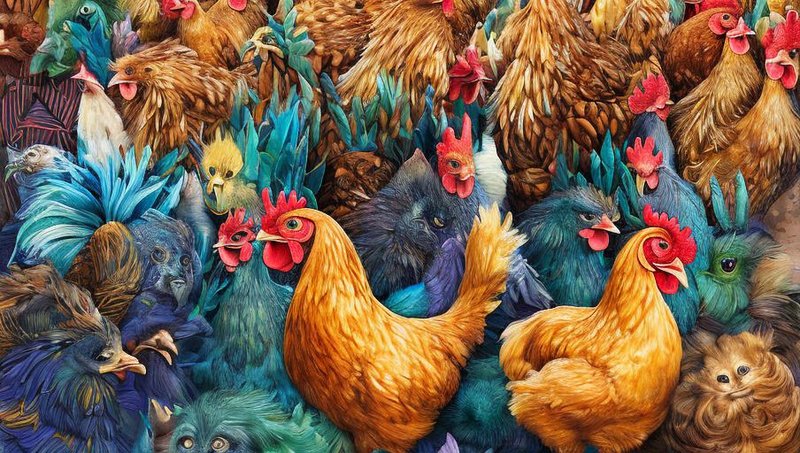
When we think of adaptation, we often picture animals in the wild, but chickens are great examples of this, too. They change their routines and social structures based on their surroundings—just like how we might dress differently depending on the weather. For instance, if it’s raining or chilly, you might grab a sweater, while a chicken might seek shelter or fluff up its feathers for warmth. Curious about how these clever birds navigate their worlds? Let me explain how chickens adapt in various ways!
The Basics of Chicken Behavior
Chickens are social animals, and their behavior is often influenced by their environment. Just like us, they thrive in a community. They form flocks and establish a pecking order, which helps them determine who gets access to food and nesting spots first. This hierarchy is essential for maintaining peace within the flock and plays a big role in their adaptation.
When chickens feel threatened, they adapt by sticking together in their flock. If one chicken spots a potential danger, like a hawk overhead, it’ll make a specific sound to alert the others. This instinct is crucial for their survival. You might be wondering how they recognize different threats—chickens have a surprisingly good ability to learn and remember, which helps them adapt to new challenges.
Additionally, chickens can also change their foraging habits based on what’s available. If they’re in a garden full of tasty bugs, they’ll focus on hunting those down. But if the ground is barren, they might turn to scratch for seeds and grains instead. This flexibility ensures they get the nutrients they need, showcasing their resourcefulness.
Physical Adaptations
Chickens have several physical traits that help them adapt to their surroundings. One of the most obvious adaptations is their feathers. These feathers serve multiple purposes: they keep chickens warm in cooler weather, provide protection from rain, and even help them regulate their temperature in the heat.
When it gets hot, you might notice chickens spreading their wings and panting. This behavior is a way for them to cool down. By spreading their feathers and allowing airflow, they can manage their body temperature more effectively. You see, just like we might find a shady spot on a hot day, chickens have their own strategies for staying comfortable.
Another interesting physical adaptation is their feet. Chickens have strong, clawed feet that they use for scratching the ground in search of food. This behavior is known as foraging. Depending on where they live—say, a sandy area versus a muddy one—they’ll adapt their foraging technique to find food. With their adaptable feet, they can dig for worms or sift through dirt with ease.
Environmental Adaptations
Chickens are incredibly versatile and can thrive in different environments. In urban settings, for example, they adapt to smaller spaces. You might find them in backyard coops where they don’t have the luxury of vast fields. In this case, they often require careful management of their living conditions, like ensuring they have enough space to move around and access to sunlight.
In contrast, chickens on a traditional farm have the freedom to roam. Here, they adapt by exploring larger areas to find food. They use their keen eyesight to spot insects and seeds from a distance, which helps them gather nutrition more efficiently. If you’ve ever seen chickens scratching around in dirt, that’s their way of adapting to their environment by seeking out sustenance.
Moreover, chickens are sensitive to temperature changes. In the heat, they may find shade or dust bathe to cool off, while in colder months, they’ll huddle together for warmth. This behavior not only keeps them comfortable but also strengthens their social bonds, further enhancing their survival chances.
Social Adaptations and Communication
Social structures are vital for chickens. They rely on communication to maintain their flock’s dynamics. Chickens use a variety of sounds to express themselves. For instance, clucks and chirps can signal contentment, while sharper calls can indicate alarm.
The ability to communicate effectively allows chickens to adapt to their environment and each other. If a newcomer joins the flock, the established members will usually display dominance through specific behaviors. This helps to prevent conflicts and keep the group organized. Just like how we might navigate a new social group, chickens establish their roles based on previous interactions.
Chickens also show signs of empathy. When one member of the flock is in distress, others may approach closely to offer comfort. This social cooperation furthers their adaptability by creating a supportive environment, which is crucial for the flock’s overall health and well-being.
Dietary Adaptations
Chickens are omnivores, which means they eat both plants and animals. This dietary flexibility helps them adapt to various environments. In the wild, they might forage for insects, seeds, and even small rodents. In a coop setting, their diet might be supplemented with grains and kitchen scraps.
Here’s the thing: a chicken’s diet is influenced by what’s available in their surroundings. If they are living in a more urban area, they might rely on garden scraps. Conversely, those in a farm setting have a wider variety to choose from. This adaptability in diet is essential for their health and ensures they get the right nutrients depending on what’s accessible.
If you’ve ever seen a chicken pecking at your garden, it’s because they’re instinctively searching for a well-rounded meal. In many ways, they are nature’s little recyclers, turning food scraps into nutrients that help them thrive!
Challenges and Threats to Adaptation
While chickens are resilient, they face challenges in adapting to their environment. Predators are perhaps the most significant threat. Whether it’s a raccoon, fox, or a hawk, these animals can pose serious risks to a flock. Chickens have adapted behaviors to cope with this, including seeking shelter and roosting at night in high places to stay safe.
Human activities can also impact a chicken’s ability to thrive. Overcrowding, poor housing conditions, and lack of access to outside spaces can lead to stress and health issues. It’s essential to provide a suitable environment where chickens can express their natural behaviors.
For many chicken owners, creating a free-range environment where chickens can explore is ideal. They not only get to forage but also engage in natural behaviors that support their well-being. If you’ve got chickens, consider how you can help them adapt positively to their living conditions.
Chickens are fascinating creatures with a remarkable ability to adapt to their environments. From their social structures and communication methods to dietary habits and physical traits, these birds show us the importance of resilience and flexibility. Whether they’re navigating the backyard or a vast farm, chickens have remarkable adaptations that help them thrive.
In a world that’s constantly changing, we could all take a lesson from chickens about how to adapt and find comfort in our surroundings. They remind us how important it is to create supportive communities, embrace our natural instincts, and, most importantly, find ways to thrive no matter where we are. So, the next time you see a chicken scratching around, remember the impressive ways they adapt to make the most of their environment!

